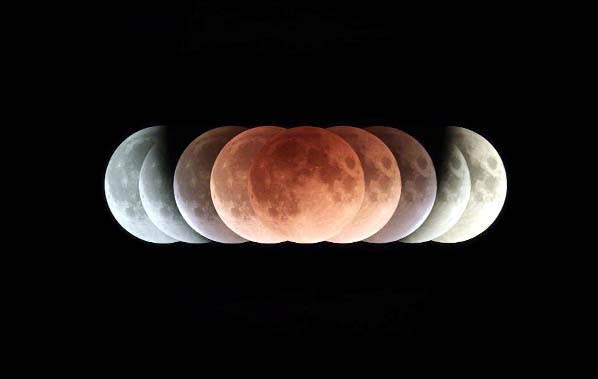
Life Desk :
Unlike the solar eclipse, lunar eclipses are less common with a maximum of three occurring every year. However, it doesn’t necessarily occur every year. Each lunar eclipse is visible from more than half the Earth.
What makes this eclipse rare?
This year, the world will witness the longest lunar eclipse of the century. The moon will be the earth’s shadow for four hours and totally eclipsed for one hour and 43 minutes, which is just short of the theoretical limit of a lunar eclipse. The reason behind it is that this time, the moon will be passing through the centre of the Earth’s shadow.
How Chandra Grahan or Lunar Eclipse occurs?
This occurrence of eclipse does not happen every time the moon orbits the earth because the orbital planes of the Earth and moon are only less different.
The two intersect at an angle of around five degrees. During the lunar eclipse, the moon will be at the farthest distance from the earth.
A red light will be reflected at the moon’s surface, thus making it look magnificent red in colour.
The eclipse will play out simultaneously over the night sky in the final hours of July 27, and the early hours of July 28. The spectacular event follows the Super Blue Blood Moon that played out on the night of January 31 across many parts of the world this year. While this event may not seem as dramatic in comparison, the moon will still be observed in hues of scarlet red.
As the moon falls into a position directly behind the Earth, thereby blocking the direct sunlight, it will acquire a reddish hue.
This phenomenon is called a Total Lunar Eclipse. During its orbit, the moon will be at its furthest distance from the Earth, making its revolution around the planet seem slower than usual.
What’s more, it will also fall under the region over which the Earth casts its shadow, called the Umbra.
This phenomenon is popularly known as Blood Moon Eclipse because the moon reflects red light off its surface. The name describes the phenomenon of Rayleigh scattering. Any interference in the way of a beam of light scatters the rays and reflects different colours. The scattering of light is the same consequence that makes skies blue and imparts an orange tinge to it during sunset.
In fact, if the same spectacle was seen from the surface of the moon, the sun could be seen setting behind the Earth, enveloping it in a glowing red shade.
Once the moon leaves the Earth’s shadow after the partial and penumbral eclipse phase, it will go back to its regular, white colour.
Unlike the solar eclipse, lunar eclipses are less common with a maximum of three occurring every year. However, it doesn’t necessarily occur every year. Each lunar eclipse is visible from more than half the Earth.
What makes this eclipse rare?
This year, the world will witness the longest lunar eclipse of the century. The moon will be the earth’s shadow for four hours and totally eclipsed for one hour and 43 minutes, which is just short of the theoretical limit of a lunar eclipse. The reason behind it is that this time, the moon will be passing through the centre of the Earth’s shadow.
How Chandra Grahan or Lunar Eclipse occurs?
This occurrence of eclipse does not happen every time the moon orbits the earth because the orbital planes of the Earth and moon are only less different.
The two intersect at an angle of around five degrees. During the lunar eclipse, the moon will be at the farthest distance from the earth.
A red light will be reflected at the moon’s surface, thus making it look magnificent red in colour.
The eclipse will play out simultaneously over the night sky in the final hours of July 27, and the early hours of July 28. The spectacular event follows the Super Blue Blood Moon that played out on the night of January 31 across many parts of the world this year. While this event may not seem as dramatic in comparison, the moon will still be observed in hues of scarlet red.
As the moon falls into a position directly behind the Earth, thereby blocking the direct sunlight, it will acquire a reddish hue.
This phenomenon is called a Total Lunar Eclipse. During its orbit, the moon will be at its furthest distance from the Earth, making its revolution around the planet seem slower than usual.
What’s more, it will also fall under the region over which the Earth casts its shadow, called the Umbra.
This phenomenon is popularly known as Blood Moon Eclipse because the moon reflects red light off its surface. The name describes the phenomenon of Rayleigh scattering. Any interference in the way of a beam of light scatters the rays and reflects different colours. The scattering of light is the same consequence that makes skies blue and imparts an orange tinge to it during sunset.
In fact, if the same spectacle was seen from the surface of the moon, the sun could be seen setting behind the Earth, enveloping it in a glowing red shade.
Once the moon leaves the Earth’s shadow after the partial and penumbral eclipse phase, it will go back to its regular, white colour.
-Internet

